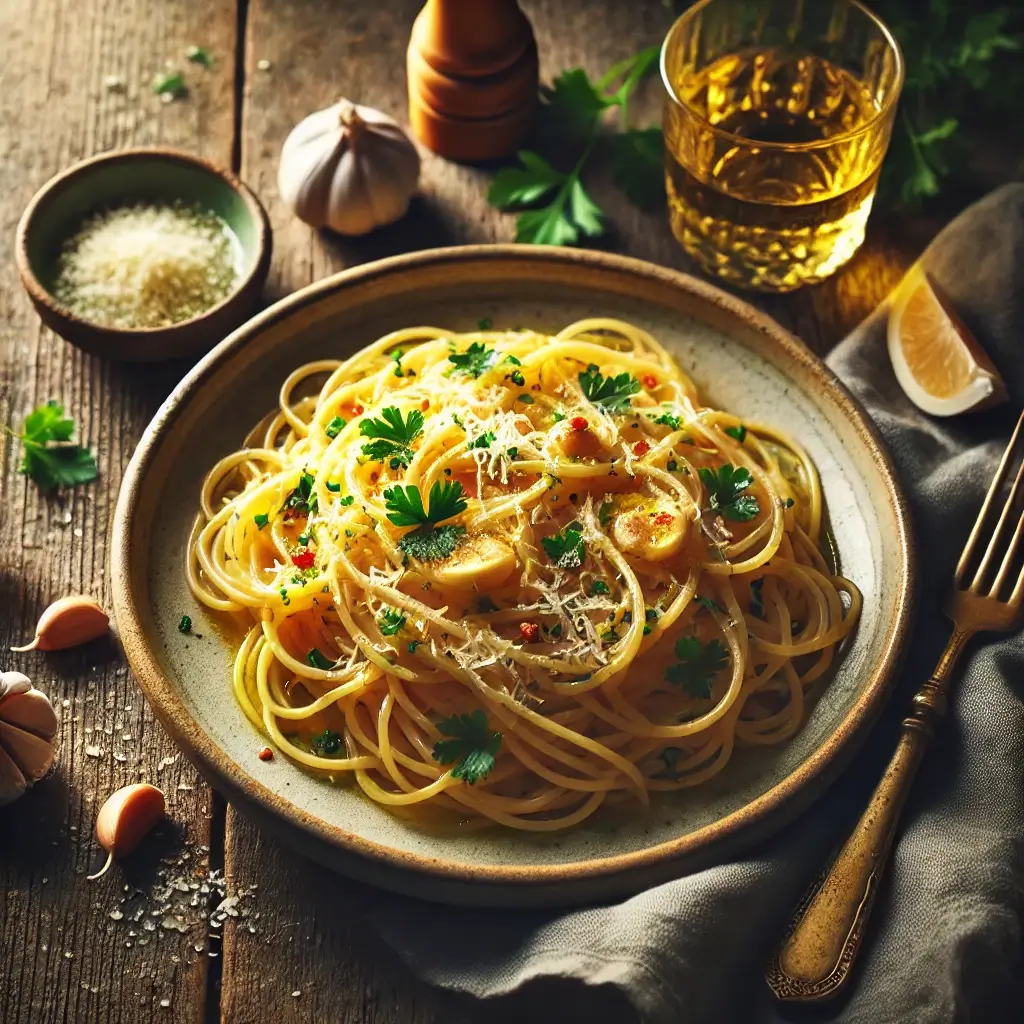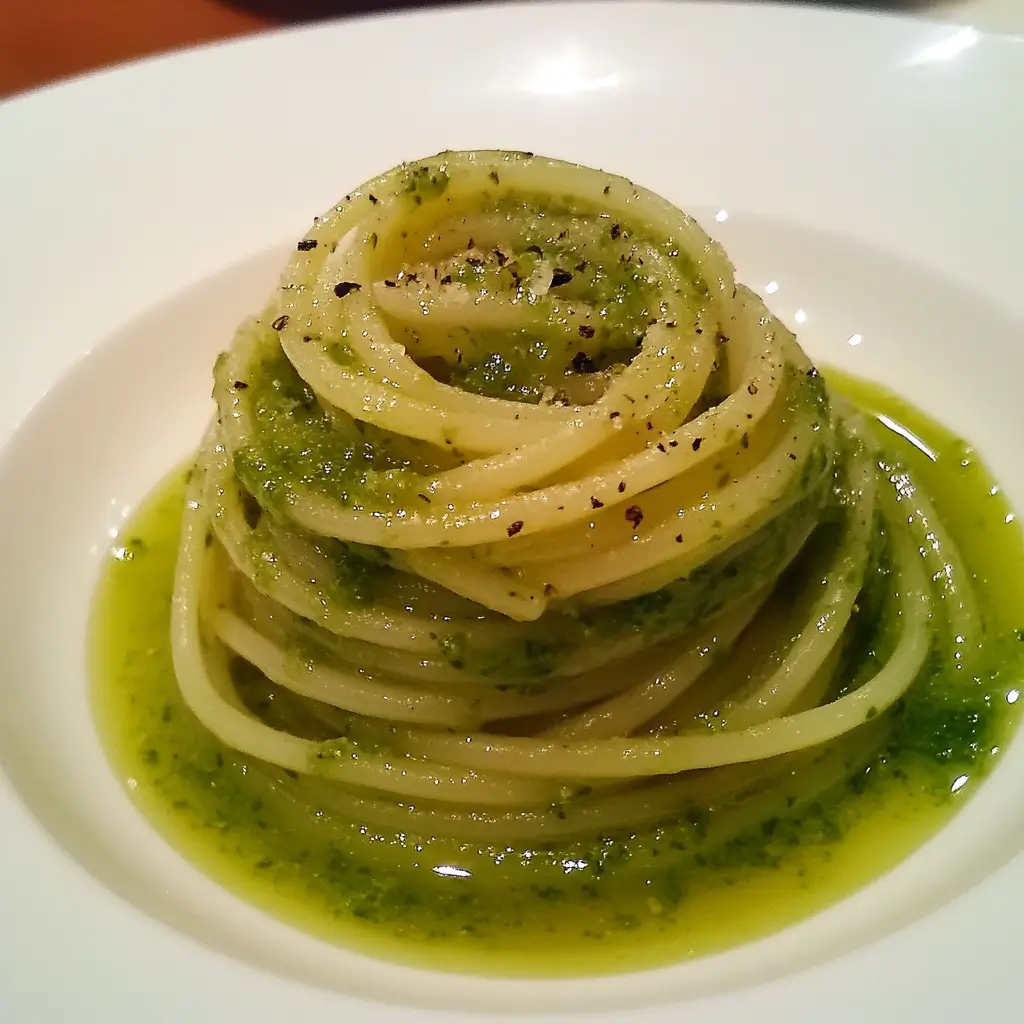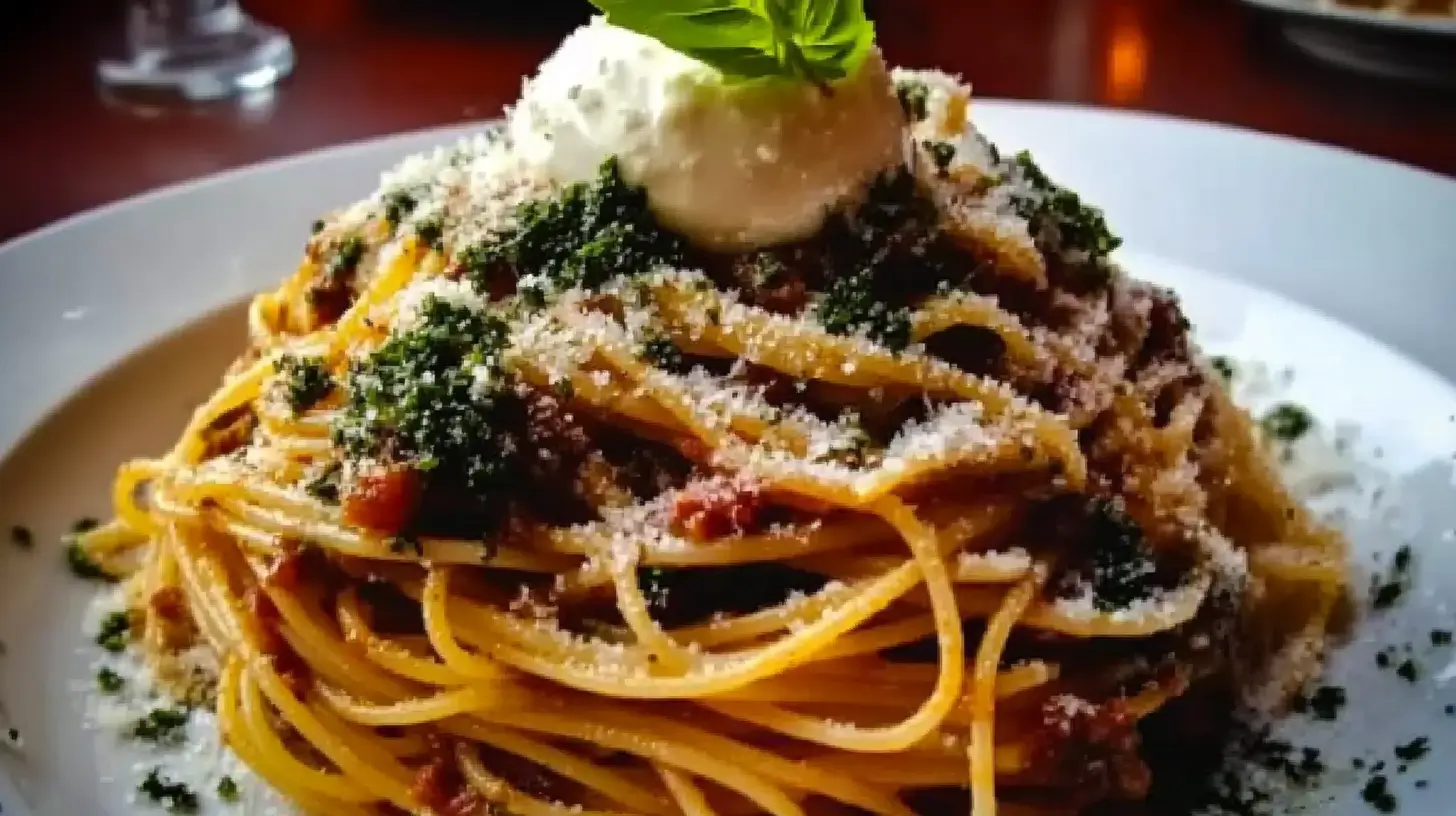If you’re craving a fast, easy, and flavorful meal, this Spaghetti Olio e Aglio recipe is your perfect solution. This Italian classic combines simple ingredients—spaghetti, olive oil, and garlic—into a dish that’s both comforting and full of flavor. Ready in under 20 minutes, it’s a go-to recipe for busy nights or when you’re short on groceries. Trust me, once you try this, you’ll see why Spaghetti Olio e Aglio is loved around the world.
Table of Contents
What is Spaghetti Olio e Aglio Recipe?
Let’s start with the basics. “Spaghetti Olio e Aglio” (say it with me: OH-lee-oh eh AH-lyoh) is an Italian phrase that translates to “spaghetti with oil and garlic.” Sounds simple, right? That’s because it is.
This dish comes from Naples, the birthplace of so many Italian classics. Back in the day, it was considered “poor man’s food” because the ingredients were cheap and always on hand. Yet over the years, it’s become a global favorite for anyone who appreciates how good garlic, olive oil, and pasta can taste when cooked just right.
It’s fast. It’s cheap. It’s loaded with flavor. And the best part? You can make it in under 20 minutes. For busy weeknights, this recipe is a total lifesaver.
Key Ingredients for Spaghetti Olio e Aglio
The beauty of Spaghetti Olio e Aglio Recipe is its simplicity. You only need a handful of ingredients, but each one plays a crucial role. Here’s what you need:
1. Spaghetti
Classic spaghetti is the star of this dish. Dried spaghetti works perfectly, but if you want to feel fancy, you can use fresh pasta.
Tip: Don’t skimp on quality! Brands like Barilla, De Cecco, or Rustichella d’Abruzzo are always reliable.
2. Extra Virgin Olive Oil
This is the soul of the dish, so use the good stuff. A high-quality extra virgin olive oil makes all the difference. Look for a rich, slightly fruity oil with a smooth finish.
3. Fresh Garlic
Garlic is the hero here, so make sure it’s fresh! You’ll want to slice it thin so it infuses the oil without burning.
4. Red Pepper Flakes
These add just the right amount of heat to balance the garlic and olive oil. Adjust the amount depending on your spice tolerance.
5. Salt
Salt is essential for cooking the pasta and enhancing the overall flavor. Use a coarse salt, like kosher salt, when boiling your spaghetti.
6. Parsley (Optional)
A sprinkle of fresh parsley adds a pop of color and a subtle freshness to the dish. It’s not mandatory, but it looks gorgeous and tastes great.
7. Parmesan Cheese (Optional)
This is a little controversial—traditional Spaghetti Olio e Aglio doesn’t include cheese. But if you’re a cheese lover (like me), a sprinkle of grated Parmesan takes it to the next level.
How to Make Spaghetti Olio e Aglio
Making Spaghetti Olio e Aglio is easy, but there’s a method to the magic. Follow these steps, and you’ll have perfect spaghetti every time.
Step 1: Boiling the Pasta Perfectly
- Boil water: Start with a large pot of water—about 4-5 quarts for every pound of spaghetti. Add a generous amount of salt. The water should taste salty like the sea.
- Add spaghetti: Once the water is at a rolling boil, drop in your spaghetti. Give it a stir to keep the noodles from sticking.
- Cook al dente: Follow the package instructions, but taste the pasta about a minute before the suggested time. You want it al dente—firm to the bite.
- Save the pasta water: Before draining, scoop out about 1 cup of pasta water. This starchy water will help create a smooth, silky sauce.
Step 2: Infusing Olive Oil with Garlic
This is where the magic happens. The key to Spaghetti Olio e Aglio is gently infusing olive oil with garlic. Here’s how:
- Heat the oil: In a large skillet, heat about 1/4 cup of olive oil over medium-low heat. Don’t rush this—you want the oil to heat gently.
- Add garlic: Toss in your thinly sliced garlic. Stir it constantly and watch closely. You’re looking for it to turn golden, not brown. Burnt garlic will taste bitter, and we don’t want that.
- Add red pepper flakes: When the garlic is perfectly golden, add a pinch of red pepper flakes. Stir for another 30 seconds to let the flavors bloom.
Step 3: Combining the Ingredients
Now comes the fun part—bringing everything together.
- Toss the spaghetti: Add the drained spaghetti directly into the skillet with the garlic oil.
- Add pasta water: Slowly pour in a bit of the reserved pasta water—start with a few tablespoons and add more as needed. This helps the oil cling to the spaghetti, creating a light, glossy sauce.
- Mix well: Use tongs to toss everything together. The spaghetti should be evenly coated with the garlic oil.
- Finish with parsley: If you’re using parsley, sprinkle it in at the end for a fresh, vibrant finish.

Serving Suggestions for Spaghetti Olio e Aglio
Spaghetti Olio e Aglio is fantastic on its own, but you can easily pair it with other dishes to make it a complete meal. Here are a few ideas:
- Garlic Bread: Because more garlic is always a good idea.
- Green Salad: A light, lemony arugula or spinach salad complements the richness of the oil.
- Roasted Vegetables: Serve with roasted broccoli, zucchini, or asparagus for extra nutrition.
- Grilled Chicken or Shrimp: If you want some protein, grilled chicken or sautéed shrimp works beautifully.
And don’t forget a glass of wine! A crisp white wine like Pinot Grigio or Sauvignon Blanc pairs perfectly with this dish.
Tips and Tricks for Perfect Spaghetti Olio e Aglio
Making Spaghetti Olio e Aglio might seem simple, but getting it just right requires a little know-how. Don’t worry—I’ve got you covered! Follow these detailed tips to elevate your dish to perfection every single time.
1. Use Quality Olive Oil
Olive oil is the heart and soul of Spaghetti Olio e Aglio, so it’s absolutely worth investing in a good one. You don’t need to break the bank, but there’s a big difference between cheap, overly processed oil and a high-quality extra virgin olive oil.
- Why it matters: Extra virgin olive oil has a deeper, more complex flavor with fruity, peppery notes that take this simple dish to another level. Since the oil is the base of your “sauce,” every drop should taste fresh and delicious.
- What to look for: Look for olive oil labeled “extra virgin” with a clear harvest date and origin. Italian, Spanish, or Greek oils are all great choices. Avoid anything labeled “light” or “refined” because they lack flavor.
Tip: Test your olive oil by dipping a piece of bread in it. If it tastes smooth and flavorful, it’s good to go.
2. Slice, Don’t Mince, the Garlic
Garlic is the star of the show in Spaghetti Olio e Aglio Recipe, so how you prepare it makes a huge difference. Always slice your garlic thinly instead of mincing or crushing it.
- Why slicing works better: Thin garlic slices cook more evenly and slowly release their flavor into the oil. Minced garlic, on the other hand, can burn in seconds, leaving a bitter taste that ruins the dish.
- How to slice garlic like a pro: Use a sharp knife and take your time. Lay each garlic clove flat on your cutting board and carefully slice it as thin as possible. If you’re in a rush, you can also use a garlic slicer or mandoline.
Fun fact: Sliced garlic not only tastes better, but it also looks prettier in the finished dish—those little golden slivers are a thing of beauty.
3. Save the Pasta Water
If there’s one secret to silky, restaurant-quality Spaghetti Olio e Aglio, it’s pasta water. That cloudy, starchy water might look unappealing, but trust me—it’s pure magic.
- Why pasta water is important: As the spaghetti cooks, it releases starch into the water. When you add a splash of that water to your olive oil and garlic, it helps emulsify everything, creating a light, silky sauce that clings to the spaghetti.
- How much to save: Before draining your pasta, scoop out about 1 cup of pasta water. You might not need all of it, but it’s better to have extra just in case.
- When to add it: Once you toss the spaghetti into the garlic oil, add a few tablespoons of pasta water at a time. Stir constantly and watch as the sauce transforms into a beautiful, glossy coating.
Tip: If your pasta looks dry, don’t panic! A little more pasta water will bring it back to life.
4. Taste as You Go
One of the best things about Spaghetti Olio e Aglio is how customizable it is. Since it only has a few ingredients, you can tweak the flavors to suit your taste.
- Salt: Taste your spaghetti before serving and add a pinch of salt if needed. The salt you add to the pasta water might be enough, but a little extra can make the flavors pop.
- Red Pepper Flakes: These add a nice kick of heat, but not everyone likes things spicy. Start with a small pinch, taste, and add more if you want a little extra zing.
- Garlic: If you’re a garlic lover, don’t be afraid to add more slices. Just be sure to cook them gently so the flavor remains sweet and nutty, not bitter.
Tip: If you accidentally go overboard on the red pepper flakes, a squeeze of lemon or an extra drizzle of olive oil can help tone down the heat.
5. Don’t Overcook the Garlic
I can’t stress this enough: do not overcook the garlic! This is the trickiest part of making Spaghetti Olio e Aglio Recipe, but once you get it right, you’ll never look back.
- Why it’s important: Garlic has a delicate, sweet flavor when cooked gently. If it burns—even just a little—it turns bitter and ruins the entire dish.
- How to avoid burning garlic:
- Use low to medium-low heat when cooking the garlic. Patience is key here—you want it to turn a soft golden color, not dark brown.
- Stir the garlic constantly to ensure it cooks evenly.
- Remove the skillet from the heat if the garlic is cooking too quickly. You can always let it cool for a moment before continuing.
Tip: Keep a close eye on the garlic. It can go from golden to burnt in a matter of seconds, so don’t get distracted—trust me, I’ve learned this the hard way!

6. Use the Right Pasta-to-Oil Ratio
One of the biggest mistakes people make when cooking Spaghetti Olio e Aglio is skimping on the olive oil. This dish isn’t meant to be dry—it’s meant to have a glossy, luscious coating of oil that carries all the garlic flavor.
- How much oil to use: For every 8 ounces (about half a box) of spaghetti, you’ll want at least 1/4 cup of olive oil. If you’re making a full pound of spaghetti, bump it up to 1/2 cup.
- Adjust as needed: If the spaghetti looks dry after tossing it in the garlic oil, add more olive oil or a splash of pasta water.
Tip: Don’t worry about the oil being “too much.” It’s what makes the dish rich, satisfying, and full of flavor.
7. Finish with Fresh Ingredients
Although Spaghetti Olio e Aglio is all about simplicity, adding a couple of finishing touches can take it from great to amazing.
- Parsley: A sprinkle of freshly chopped parsley adds color and a touch of freshness. It balances the richness of the oil and garlic beautifully.
- Lemon Zest: For a bright, citrusy flavor, grate a little lemon zest over the pasta just before serving. It’s a game-changer.
- Parmesan Cheese: While traditional recipes skip the cheese, a light dusting of freshly grated Parmesan adds a lovely depth of flavor.
Tip: If you want to keep the dish vegan, skip the cheese and stick with parsley and lemon.
Health Benefits of Spaghetti Olio e Aglio
Believe it or not, Spaghetti Olio e Aglio is not just tasty—it’s also good for you!
- Olive Oil: Packed with heart-healthy fats and antioxidants, olive oil can help lower cholesterol and reduce inflammation OIL EU
- Garlic: Garlic has antibacterial and antiviral properties, making it a natural immune booster. It’s also great for heart health.
- Low in Processed Ingredients: This recipe is free of artificial additives and processed foods.
Plus, it’s naturally vegetarian and can easily be made vegan—just skip the Parmesan.

More Easy Recipes to Try
For more quick and delicious recipes, check out:
- The Ultimate Waffle Banana Recipe Guide: Perfect Every Time – A sweet and satisfying breakfast treat.
- Easy Chicken Pasta Recipes Without Cream – Quick, healthy, and creamy-free chicken pasta ideas.
- Low Carb Chicken Tacos – A delicious option for a lighter meal.
- Healthy Chicken Sausage Recipes – Nutritious meals packed with protein.
These recipes are perfect for busy weeknights when you need something quick but satisfying.
Why Spaghetti Olio e Aglio is a Global Favorite
So, why do people around the world love this simple dish? It’s all about the magic of simplicity. Spaghetti Olio e Aglio proves you don’t need a complicated recipe to create a satisfying, restaurant-quality meal.
In Italy, it’s a go-to late-night snack after a night out with friends. In the U.S., it’s the perfect solution for busy weeknights when you don’t feel like cooking. And no matter where you are, it’s guaranteed to be a crowd-pleaser.
Whether you’re feeding a family, cooking for yourself, or impressing a date, Spaghetti Olio e Aglio never disappoints.
FAQs
Do Italians eat aglio olio?
Yes, Italians love aglio e olio! It’s a classic dish, especially popular in Naples, for its simplicity and bold flavors.
Why is my aglio olio bitter?
Your garlic may have burned. Cook it on low heat until golden, not brown, to avoid bitterness. Also, use quality olive oil.
What type of olive oil is best for aglio olio?
Use extra virgin olive oil. It’s rich, flavorful, and perfect for this dish since it’s the main ingredient.
How can I make my aglio olio taste better?
Add a pinch of red pepper flakes for heat, finish with fresh parsley, or a touch of lemon zest for brightness.
Do Italians use butter or olive oil on pasta?
Italians traditionally use olive oil, especially in aglio e olio. Butter is rare in southern Italian pasta dishes.
Do you put Parmesan in aglio e olio?
Traditionally, no. But if you like it, a sprinkle of Parmesan adds richness—just know it’s a personal touch!
Final Thought
There you have it—the ultimate guide to making the best Spaghetti Olio e Aglio Recipe at home. It’s quick, easy, and oh-so-satisfying.
So the next time you’re staring at your pantry wondering what to cook, grab some spaghetti, olive oil, and garlic. You’ll be amazed at how something so simple can taste so good.
Happy cooking, and don’t forget—garlic breath is a small price to pay for a plate of pasta this delicious.
